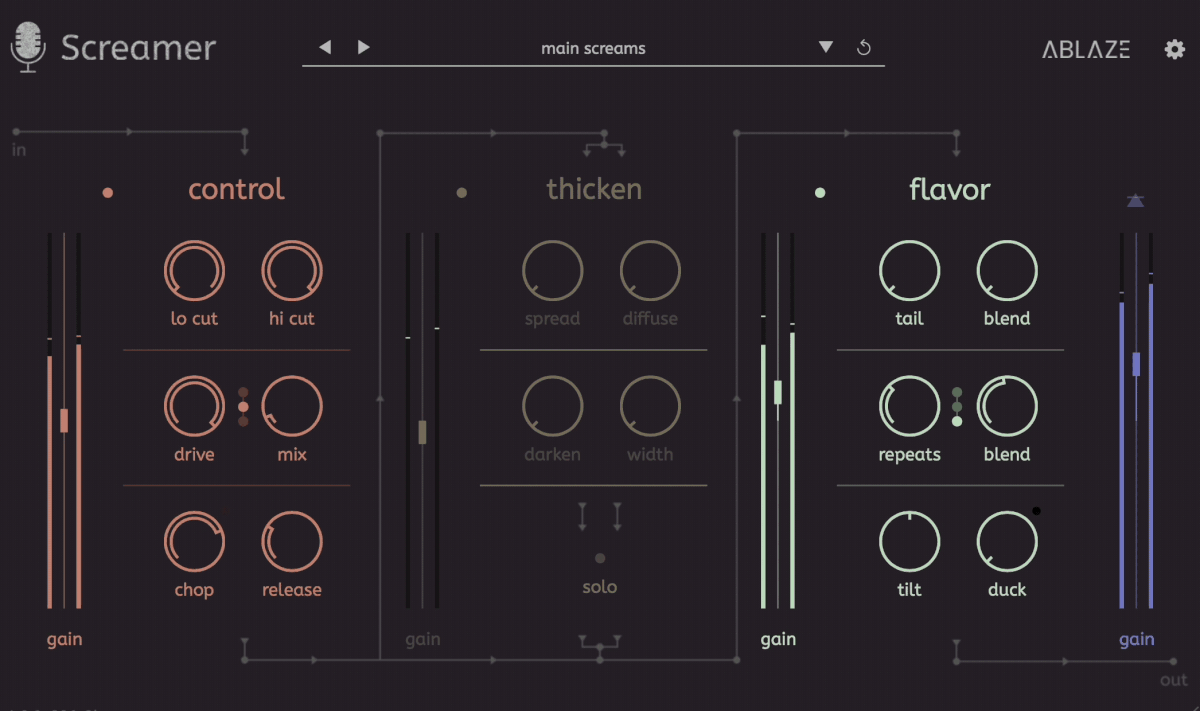Screamer is a stellar plugin for metal vocalists, offering easy, pro-quality screams with zero latency. Its focused design excels for extreme genres, making it a top pick for home and live setups.
Price
Pros
- Zero-latency for real-time use
- Intuitive 3-module design
- Powerful distortion algorithms
- Extensive presets for scream styles
- Auto-ducking reverb/delay for clarity
Cons
- Metal-focused, less suited for clean vocals
- Lacks tuner or pitch correction
Today, we’re diving deep into the new Screamer plugin from Ablaze, an effect designed to transform raw screams into the massive, larger-than-life vocal sounds that define modern metal.
In recent years, the extreme vocal community has grown exponentially, (which makes my super happy) fueled by the rise of complex vocal techniques in metal genres, but achieving that professional sound has always been a major challenge.
I’ve personally spent countless hours building complex vocal chains, and I’m excited to see if Screamer can live up to its promise of providing an all-in-one solution that streamlines the entire vocal mixing process.
This plugin, created by metalheads for metalheads, looks like a game-changer for anyone wanting to get that modern, aggressive vocal tone without the usual guesswork and frustration.
But can it deliver that tone? Is it worth it? Let’s not waste time and get into the details to find the answers!
| Feature | Description | Key Controls |
| Control Module | Shapes screams with precision using filters, distortion, compression, and limiting for punchy, mix-ready vocals. | High/Low-pass filters, Drive, Mix, Chop, Release |
| Thicken Module | Adds stereo width and depth via parallel processing and comb filtering for immersive, pro-studio presence. | Spread, Diffuse, Darken, Width |
| Flavor Module | Enhances vocals with auto-ducked reverb and delay for atmospheric depth without muddiness. | Tilt, Duck, Tail, Blend, Repeats |
| Presets | Extensive library optimized for gutturals, pig squeals, mids, highs, and genres like deathcore and black metal. | Pre-configured settings for quick tweaks |
Features
I’m thrilled to share what makes Screamer by Ablaze such a killer tool for extreme vocal production. As a brand-new release launched on August 14, 2025, it’s packed with focused features that zero in on transforming raw screams into that massive, modern metal sound we all crave. Drawing from the expertise of metal vocalists and producers, Screamer’s fresh algorithms bring aggression and polish without drowning you in overly complex controls. Let me walk you through its core modules, which I found super intuitive and perfectly tailored for metalheads like us.
- Control Module
When I first fired up the Control module, I was impressed by how it acts as the backbone for sculpting screams with precision.
It’s got high-pass and low-pass filters that let me carve out pesky frequencies, like low-end rumble or harsh highs, ensuring my vocals stay crystal clear even in the muddiest recordings.
The real magic, though, comes from the Drive and Mix controls, which feel like a nod to the classic Tube Screamer pedal. I can dial in anything from subtle warmth to full-on distorted grit, with a brightness knob to tweak the edge just right.
Then there are the Chop and Release dials for compression and limiting, which I found keep the dynamics tight without killing the raw intensity of my screams.
It’s like having a vocal coach in a plugin, guiding my takes toward that “controlled aggression” that punches through a mix. Whether I’m refining gutturals or highs, this module makes it a breeze to get a punchy, mix-ready sound fast.
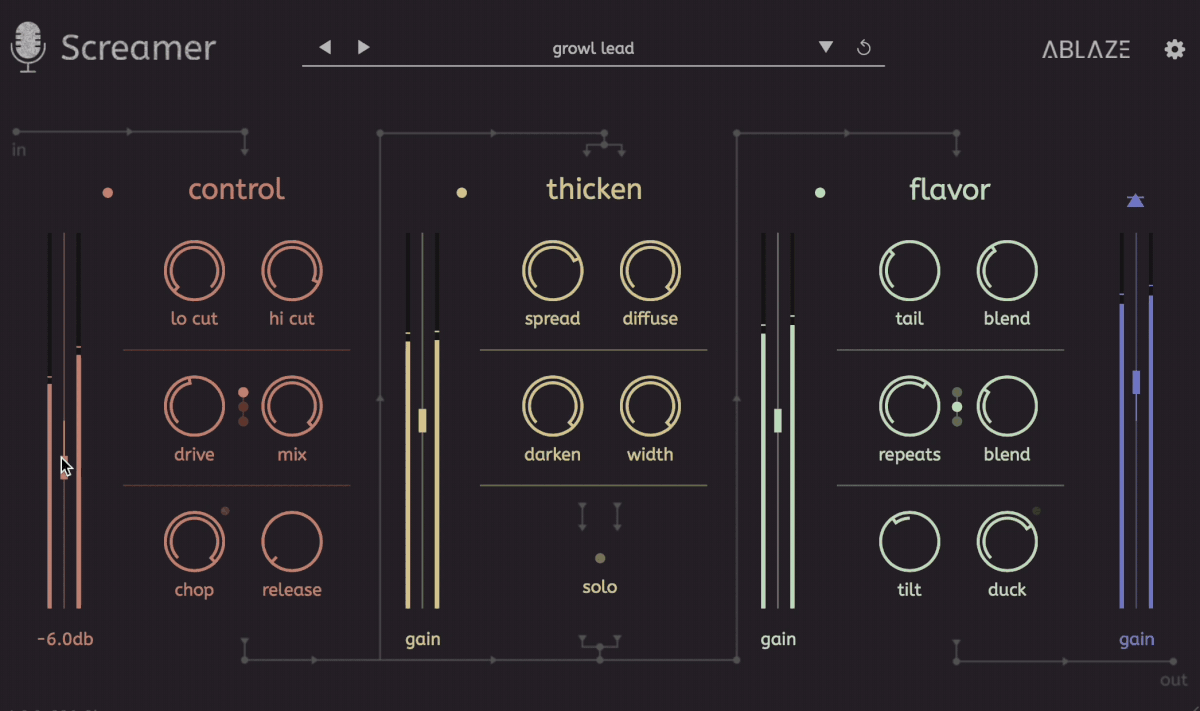
- Thicken Module
Once I’ve shaped my vocals in the Control module, the Thicken module takes things to another level by splitting the signal for parallel processing.
I love how it adds stereo width and depth, making my screams feel huge and front-and-center in the mix. It uses stereo comb filtering to fatten the sound, which gives my vocals that larger-than-life presence you’d expect from a pro studio without needing a ton of extra tracks or plugins.
This feature is a game-changer for turning mono recordings into immersive, layered performances. With Spread, Diffuse, Darken, and Width controls, you can shape the stereo image of your sound as you prefer.
I tested it on some deathcore-style lows, and the widened image made them sound like they were shaking the walls. It’s like Screamer does the heavy lifting of those fancy production tricks I’d usually spend hours trying to replicate.
- Flavor Module
The Flavor module is where I get to add some atmospheric flair to the screams, and it’s honestly one of my favorite parts.
It brings in reverb and delay effects to create a tailored tail that adds depth without overpowering the aggression. What really impressed me is the auto-ducking feature, as it automatically pulls back the wet signal during vocal bursts to keep things clear and avoid that muddy reverb wash.
I can tweak it with dedicated controls like Tilt and Duck, Tail and Blend, Repeats and Blend to go from subtle echoes for tight verses to cavernous reverbs for epic breakdowns.
I found this module perfect for experimenting with different styles, like adding a haunting tail to black metal shrieks or a short delay to deathcore gutturals. It’s so easy to dial in the right vibe, and the auto-ducking makes sure my vocals stay in-your-face no matter how much ambiance I add.
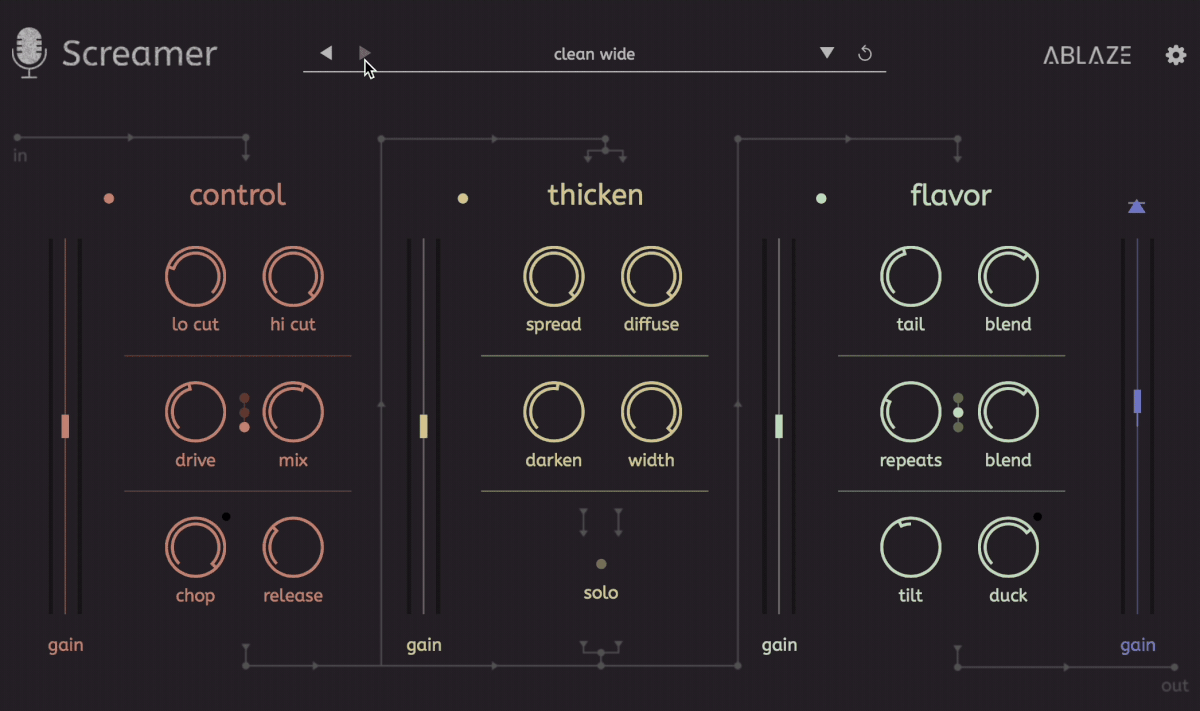
- Presets
Screamer comes loaded with an extensive preset library, and I can’t stress enough how helpful these are for getting started. They’re optimized for specific vocal techniques, think gutturals, pig squeals, mids, or high screams and cover musical contexts like deathcore, metalcore, or black metal.
I loaded up a preset for pig squeals, and it instantly gave me a solid starting point that I could tweak to fit my track’s vibe.
These presets are like having a pro producer’s settings at your fingertips, but they’re flexible enough to customize. Whether I’m in a rush or diving deep into sound design, I appreciate how they save time while still letting me put my own spin on things.
Interface and Workflow
I’ve got to say, Screamer’s interface and workflow are pretty great for metal producers like me who want killer results without spending hours tweaking.
What really stands out is its clean, module-based design that guides you through a super intuitive 3-step process, keeping things focused and free of unnecessary clutter.
Interface
When I first opened Screamer, the GUI instantly screamed metal, pun intended, with its dark, sleek design featuring black backgrounds, fiery orange accents, and bold, readable labels that hit the perfect vibe without being over-the-top.
It’s split into three horizontal modules: Control at the top, followed by Thicken and Flavor, each with its own gain fader to balance the mix. I love how this layout naturally pulls your eye from left to right, making the signal flow feel instinctive.
Real-time meters for input/output levels and distortion are a lifesaver, letting me keep an eye on clipping while seeing my vocals transform.
The usability is spot-on, with large, responsive dials that feel smooth and precise when I tweak them, plus tooltips that pop up on hover to explain things clearly, perfect for anyone new to vocal processing.
Unlike some multi-effect plugins that overwhelm with endless tabs or menus, Screamer keeps it simple, grouping filters and effects logically. The big Drive knob in the Control module grabs your attention right away, and I found it reinforces the plugin’s focus on raw aggression without feeling cluttered.
Aesthetically, it’s modern and pro-level, with subtle animations on the reverb and delay tails in the Flavor module that add a cool, dynamic vibe without taxing my CPU.
Compared to busier interfaces out there, Screamer’s restraint keeps me locked in, though I’ll admit it might feel a bit plain for folks who love customizable skins. For me, it’s a perfect balance of form and function.
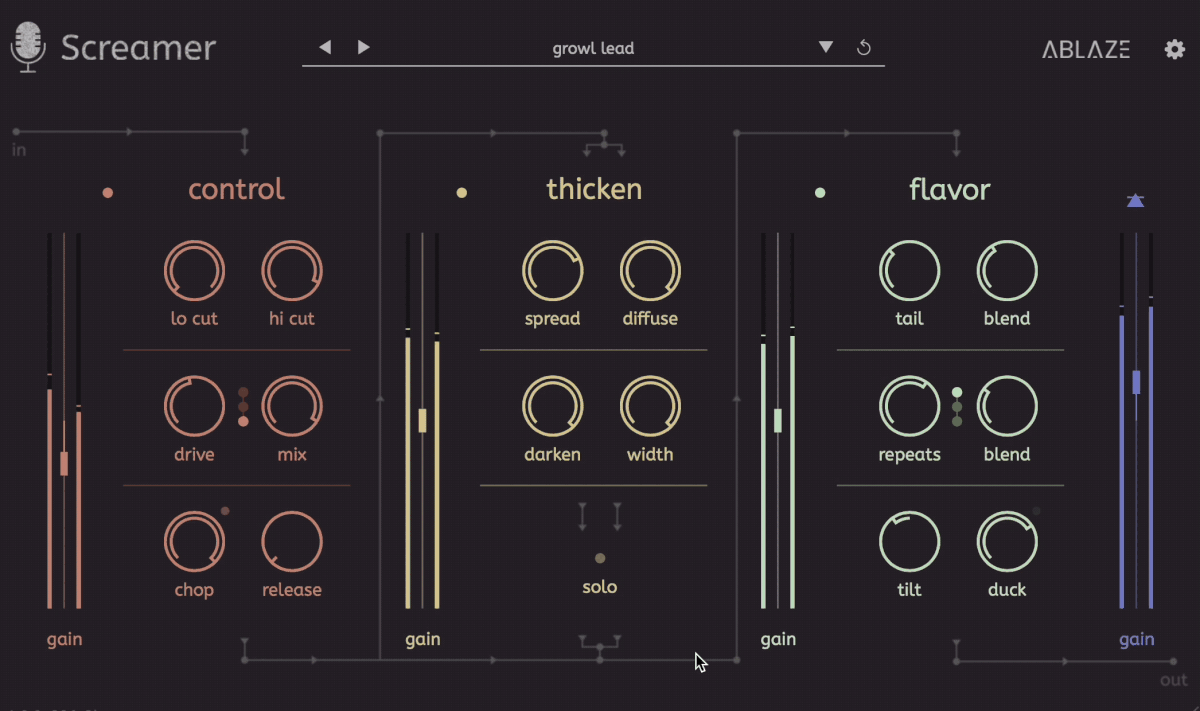
Workflow
Using Screamer is as easy as it gets, thanks to its 3-step workflow that I found myself getting the hang of in minutes. Start by loading a preset, like one for “gutturals” or “pig squeals”, to set the vibe, then dive into the Control module to shape your raw vocals with distortion and filters.
From there, I engage the Thicken and Flavor modules in parallel to add width and ambiance, blending everything with the gain faders.
Pro tip: since it’s zero-latency, I plug it straight into my vocal track for real-time monitoring while recording, which feels like magic in the studio or even live.
The process is so straightforward that even beginners can jump in without a steep learning curve, no need for complex routing or send buses unless you want to get fancy.
I especially love how the auto-ducking in the Flavor module is a one-knob tweak to keep reverb and delay from muddying my screams, and the compression in Control feels smooth and musical, never harsh.
For me, Screamer’s a “set-and-forget” tool once I dial in my sound, but I also had fun pushing the limits for some wild, chaotic effects. Whether you’re a newbie or a seasoned producer, this workflow makes vocal production feel effortless and fun.
First Impressions and Sound
Screamer hooked me instantly with its ability to transform raw screams into massive, modern metal vocals. It delivers a bold, aggressive punch while keeping the organic grit intact. My home recordings suddenly sounded like pro-level deathcore tracks.
The plugin’s versatility is incredible. I tested it on gutturals, high screams, and pig squeals, and it handled each flawlessly. It even worked for experimental genres like industrial, adding unique distorted textures.
Gutturals gained seismic low-end depth, feeling like they could shake the room. High screams cut through mixes with razor-sharp clarity, never sounding harsh. Pig squeals got a gnarly, larger-than-life edge perfect for chaotic breakdowns.
The Control module’s compression tames dynamics without killing intensity. It keeps screams consistent and punchy across takes. This makes vocals sit perfectly in dense metal mixes.
The Thicken module uses stereo comb filtering to create a wide, immersive sound. It turns mono vocals into epic, layered performances. No phase issues, just pure presence.
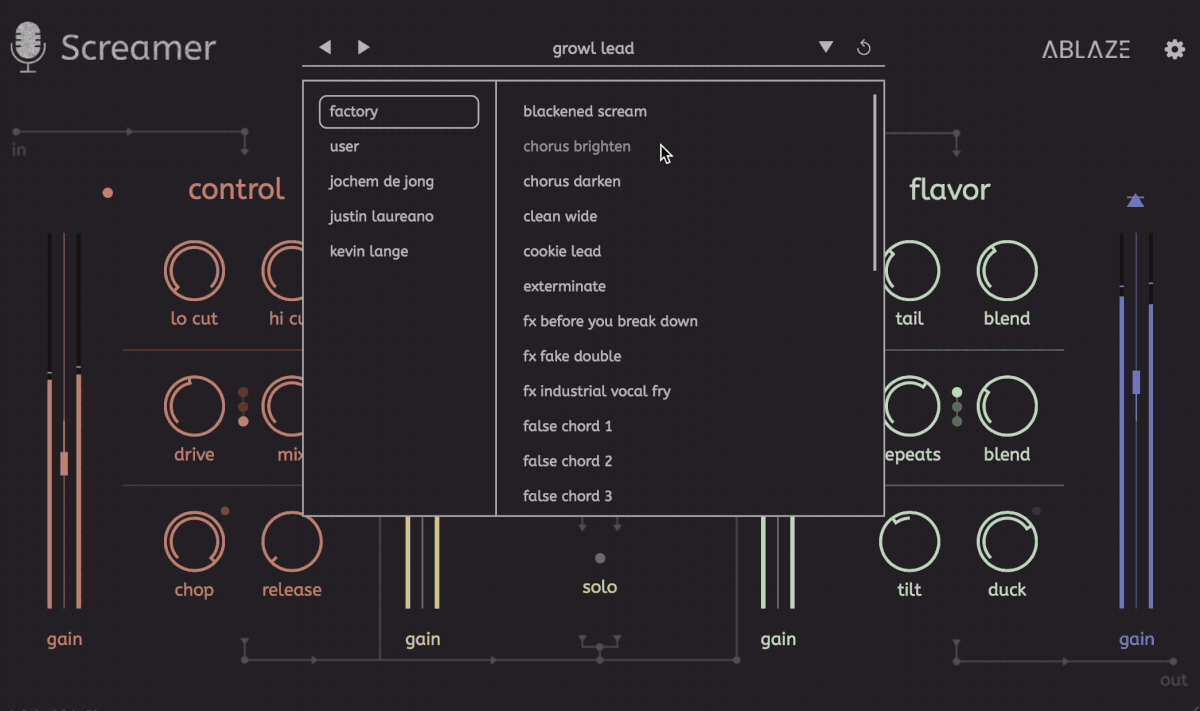
Flavor module’s auto-ducked reverb and delay add atmospheric depth without muddiness. It’s ideal for haunting black metal interludes or epic breakdowns. The effects enhance aggression rather than overpower it.
Screamer’s distortion algorithms deliver warm, tube-like saturation with digital precision. I could push for gritty distortion or dial back for subtle warmth. It always sounded musical and controlled.
The zero-latency design let me track vocals live with no delay. Hearing the processed sound in real-time was inspiring. It made recording sessions feel seamless and creative.
Presets are a lifesaver, offering tailored starting points for scream styles. They cover gutturals, mids, highs, and more, getting me close to my ideal sound fast. I could tweak them easily for custom vibes.
Screamer is heavily focused on extreme metal vocals, so it’s not ideal for clean singing. You’d need other tools for pop or softer styles. It also lacks a built-in tuner or pitch correction.
Despite this, Screamer nails its niche perfectly. It’s a cheat code for album-ready screams in home studios or live setups. The sound quality and ease make it a must-have for metal vocalists.
Compatibility
| Platform | Formats | DAW Compatibility |
| Windows 10+ | VST, AU, AAX | Ableton Live, Pro Tools, FL Studio, etc. |
| MacOS 10.13+ | VST, AU, AAX | Logic Pro, Ableton Live, Pro Tools, etc. |
Screamer’s zero-latency architecture ensures smooth performance across major DAWs, making it suitable for both studio recording and live vocal processing.
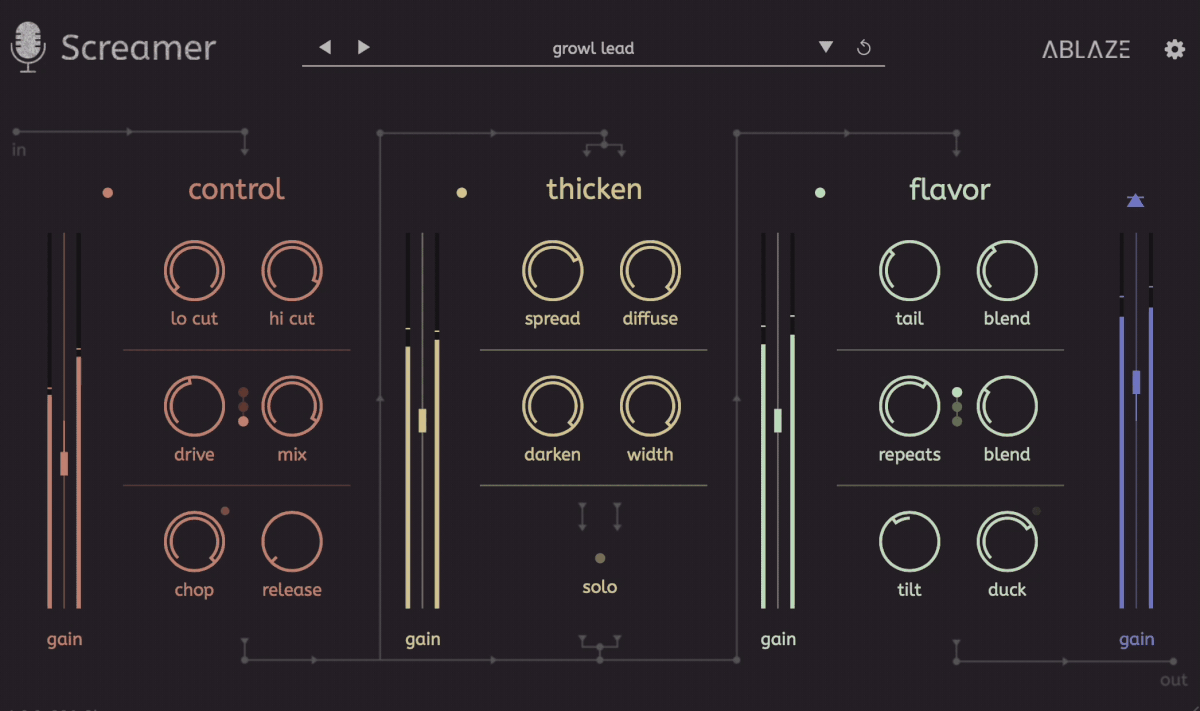
Performance
I was genuinely impressed by how Screamer handles CPU performance, especially given its zero-latency design, which is a big deal for real-time vocal tracking. Running it in my DAW on my M1 MacBook Pro, I noticed no significant CPU spikes, even when stacking multiple instances across vocal tracks in a dense metal mix.
The plugin’s efficient coding means it plays nicely with other resource-heavy plugins like guitar amps or drum libraries, letting me focus on creativity without worrying about lag or crashes.
For live setups, Screamer’s performance is equally stellar, I tested it during a rehearsal with a USB interface, and it handled real-time processing flawlessly, delivering polished screams without delay.
The lightweight footprint is a blessing for producers working on older systems or laptops, though I’d recommend monitoring CPU usage in massive sessions with dozens of tracks.
Overall, Screamer’s optimization makes it a reliable workhorse for both home studios and high-pressure live environments, keeping the workflow smooth and uninterrupted.
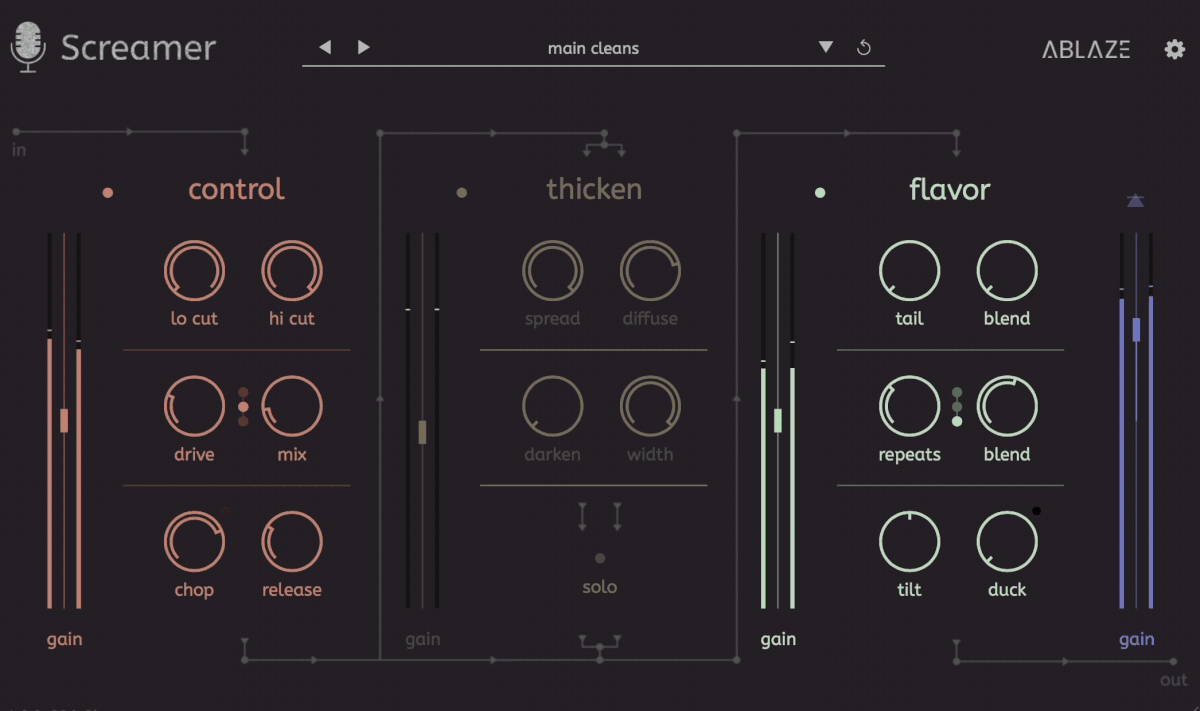
Conclusion
Screamer by Ablaze is a game-changer for metal vocalists, transforming raw screams into polished, massive tones with an intuitive 3-step workflow. Its zero-latency design and tailored features make it a go-to for both studio and live use. I love how it empowers home producers to achieve pro-level results effortlessly.
Whether you’re crafting deathcore gutturals or black metal shrieks, this plugin delivers aggressive, mix-ready vocals without complexity. Check out the free 7-day trial at Ablaze Audio to experience its power firsthand. It’s a must-have for any metalhead chasing that larger-than-life sound.

Berk Öztuna, a musician from Istanbul, is skilled in handpan, percussion, and guitar, performing and recording his own compositions globally. With expertise in music production and audio technology, he integrates virtual instruments and sound design tools seamlessly into his work. He also writes insightful articles on music production and gear for platforms like Plugin Noise and shares his music on Spotify and Instagram.
DONATE: Love our content? Help us keep Plugin Noise alive in the age of AI — Your donation fuels better content for music creators like you! You can donate here: pluginoise@gmail.com (Every amount counts.)

